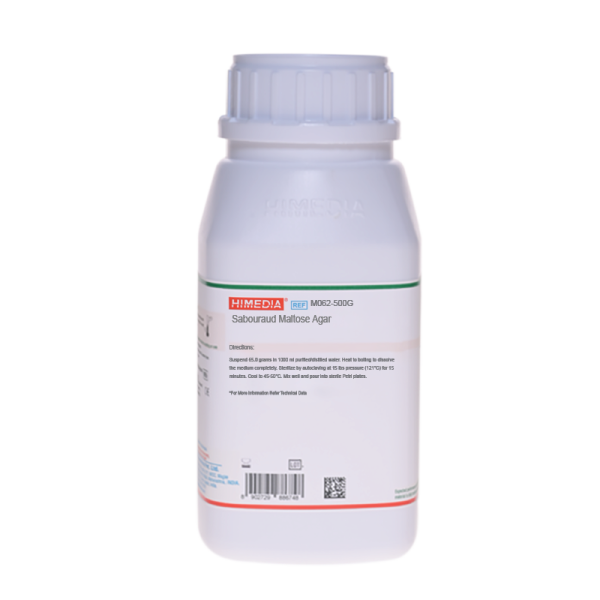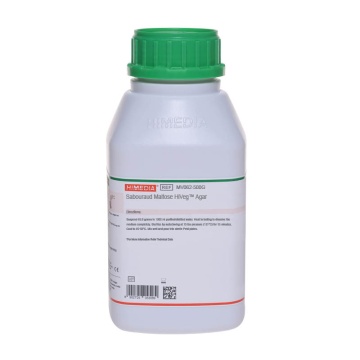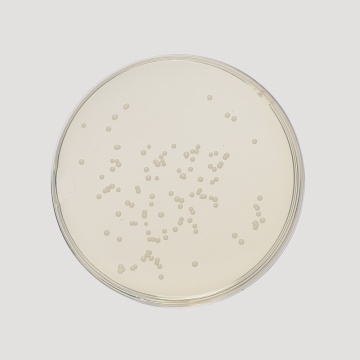 Your enquiry has been submitted
Your enquiry has been submitted
Sabouraud Maltose Agar
Intended Use:
Recommended for propagation of yeasts and moulds, particularly the parasitic fungi concerned with skin and scalp lesions.
Composition
| Ingredients | g/L |
|---|---|
| Maltose | 40.000 |
| Mycological peptone | 10.000 |
| Agar | 15.000 |
| Final pH (at 25°C) | 5.6±0.2 |
**Formula adjusted, standardized to suit performance parameters
Directions
Suspend 65 grams in 1000 ml purified / distilled water. Heat to boiling to dissolve the medium completely. Sterilize by autoclaving at 15 lbs pressure (121°C) for 15 minutes. Cool to 45-50°C. Mix well and pour into sterile Petri plates.
Principle And Interpretation
Fungi were among the first microorganisms recognized because some of the fruiting structures, such as the mushrooms, are large enough to be seen without a microscope. Fungi can be grouped simply on the basis of morphology as either yeasts or moulds (1). Sabouraud Maltose Agar was formulated by Sabouraud (2) and is used for the isolation and differentiation of yeast and moulds. (3,4,5)
Mycological peptone provides nitrogen, vitamins, minerals, amino acids and growth factors. Maltose provides an energy source for the growth of microorganisms. The low pH favours fungal growth and inhibits contaminating bacteria from clinical specimens (6). The acid reaction of the final medium is inhibitory to a large number of bacteria making it particularly useful for cultivating fungi and aciduric microorganisms. For isolation of fungi from contaminated specimens, a selective medium should be inoculated simultaneously. Incubate cultures for 4 to 6 weeks before reporting as negative.
Type of specimen
Clinical samples - skin and scalp lesions, etc.
Specimen Collection and Handling:
For clinical samples follow appropriate techniques for handling specimens as per established guidelines (6,7).
After use, contaminated materials must be sterilized by autoclaving before discarding.
Warning and Precautions :
In Vitro diagnostic Use only. For professional use only. Read the label before opening the container. Wear protective gloves/protective clothing/eye protection/ face protection. Follow good microbiological lab practices while handling specimens and culture. Standard precautions as per established guidelines should be followed while handling clinical specimens. Safety guidelines may be referred in individual safety data sheets.
Limitations :
- Individual organisms differ in their growth requirement and may show variable growth patterns on the medium.
- Each lot of the medium has been tested for the organisms specified on the COA. It is recommended to users to validate the medium for any specific microorganism other than mentioned in the COA based on the user's unique requirement.
- Further biochemical and serological tests must be carried out for further identification.
Performance and Evaluation
Performance of the medium is expected when used as per the direction on the label within the expiry period when stored at recommended temperature.
Quality Control
Appearance: Cream to yellow homogeneous free flowing powder
Gelling: Firm, comparable with 1.5% Agar gel
Colour and Clarity of prepared medium: Light amber coloured clear to slightly opalescent gel forms in Petri plates
Reaction: Reaction of 6.5% w/v aqueous solution at 25°C. pH : 5.6±0.2
pH: 5.40-5.80
Cultural Response
Cultural characteristics observed after an incubation at 25 - 30°C for 48 - 72 hours.(Incubate Trichophyton species for for upto 7 days)
| Organism | Inoculum (CFU) | Growth | Recovery |
|---|---|---|---|
| #Aspergillus brasiliensis ATCC 16404 (00053*) | 50-100 | good-luxuriant | |
| Candida albicans ATCC 10231 (00054*) | 50-100 | good-luxuriant | >=70% |
| Escherichia coli ATCC 25922 (00013*) | 50-100 | good-luxuriant (Inhibited on media with lower pH) | >=70% |
| Lactobacillus casei ATCC 9595 | 50-100 | good-luxuriant | >=70% |
| Saccharomyces cerevisiae ATCC 9763 (00058*) | 50-100 | good-luxuriant | >=70% |
| Trichophyton rubrum ATCC 28191 | 50-100 | good-luxuriant |
Key: *Corresponding WDCM numbers. #- Formerly known as Aspergillus niger
Storage and Shelf Life
Store between 10-30°C in a tightly closed container and the prepared medium at 20-30°C. Use before expiry date on the label. On opening, product should be properly stored dry, after tightly capping the bottle in order to prevent lump formation due to the hygroscopic nature of the product. Improper storage of the product may lead to lump formation. Store in dry ventilated area protected from extremes of temperature and sources of ignition Seal the container tightly after use. Product performance is best if used within stated expiry period.
Disposal
User must ensure safe disposal by autoclaving and/or incineration of used or unusable preparations of this product. Follow established laboratory procedures in disposing of infectious materials and material that comes into contact with clinical sample must be decontaminated and disposed of in accordance with current laboratory techniques (6,7).
Reference
- Murray P. R., Baron J. H., Pfaller M. A., Jorgensen J. H. and Yolken R. H., (Ed.), 2003, Manual of Clinical Microbiology, 8th Ed., American Society for Microbiology, Washington, D.C.
- Sabouraud R., 1892, Ann. Dermatol. Syphil. 3: 1061.
- Davidson and Dowding, 1932, Arch. Dermatol. Syphilol. 26:660.
- Davidson, Dowding and Buller. 1932. Can. J. Res. 6:1.
- Frank L. S., 1932, Arch. Dermatol. Syphilol., 26: 457
- Isenberg, H.D. Clinical Microbiology Procedures Handbook 2nd Edition.
- Jorgensen, J.H., Pfaller, M.A., Carroll, K.C., Funke, G., Landry, M.L., Richter, S.S and Warnock., D.W. (2015) Manual of Clinical Microbiology, 11th Edition. Vol. 1.
| Product Name | Sabouraud Maltose Agar |
|---|---|
| SKU | M062 |
| Product Type | Regular |
| Physical Form | Powder |
| Origin | Animal |
| Packaging type | HDPE |
| References | 1. Murray P. R., Baron J. H., Pfaller M. A., Jorgensen J. H. and Yolken R. H., (Ed.), 2003, Manual of Clinical Microbiology,8th Ed., American Society for Microbiology, Washington, D.C. 2.Sabouraud R., 1892, Ann. Dermatol. Syphil. 3 : 1061. 3.Davidson and Dowding, 1932, Arch. Dermatol. Syphilol. 26:660. 4.Davidson, Dowding and Buller. 193 2.Can. J. Res. 6:1. 5.Frank L. S., 1932, Arch. Dermatol. Syphilol., 26: 457 |
| Customized Product Available | No |







